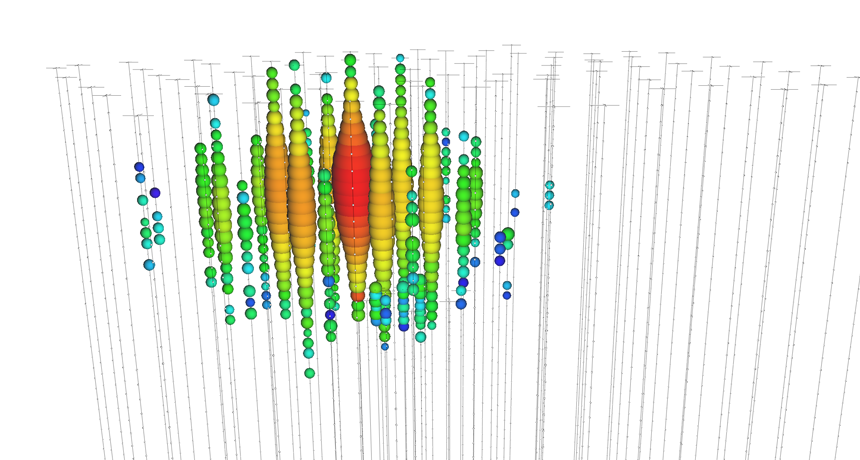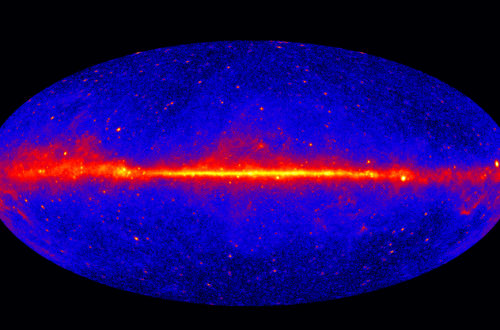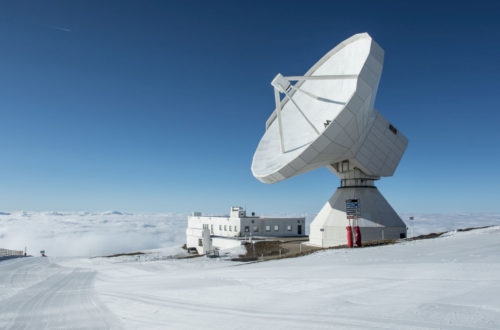On 18 December 2010, a huge human task was accomplished. 5,160 spherical optical sensors called Digital Optical Modules (DOMs) were transported and placed under the frozen surface of Antarctica. 52 institutions from 12 countries around the globe contributed (and still do) to this collaboration. The DOMs, attached to 86 vertical “strings”, cover a cubic-kilometer area from 1,450 meters to 2,450 meters depth (see Fig. 1) and are designed to indirectly detect neutrinos. Thus the first, and so far the only, cubic-kilometer neutrino telescope was born! This telescope is called the IceCube South Pole Neutrino Observatory.

Figure 1. IceCube detector scale. Image: IceCube Collaboration. From here.
Neutrinos are electrically neutral subatomic particles that interact very rarely with matter. When they do interact with the molecules of water in the ice, they produce charged leptons (electrons, muons, or taus). These charged particles emit Cherenkov radiation when traveling faster than the speed of light in the medium. This radiation is then collected by the DOMs and sent to the surface of the glacier on a cable. These signals are collected in a surface counting-house, and some of them are sent north via satellite for further analysis. Since 2014 hard drives, rather than tape, store the balance of the data which is sent north once a year via ship. Once the data reaches the scientists, they can reconstruct parameters of the incoming neutrino. High-energy neutrinos may cause a large signal in the detector, pointing back to their origin. Clusters of such neutrino directions indicate point sources of neutrinos.
Each of the above steps requires a certain minimum energy, and thus IceCube is sensitive mostly to high-energy neutrinos, in the range of 1011 to about 1021 eV.
IceCube is more sensitive to muons than other charged leptons because they are the most penetrating and thus have the longest tracks in the detector (see Fig. 2). Thus, of the neutrino flavors, IceCube is most sensitive to muon neutrinos.

Figure 2. Event display for the track neutrino event IceCube-170922A. The time at which a DOM observed a signal is reflected in the color of the hit, with dark blues for earliest hits and yellow for the latest. Times shown are relative to the first DOM hit according to the track reconstruction, and earlier and later times are shown with the same colors as the first and last times, respectively. The total time the event took to cross the detector is ~3000 nanoseconds. The size of a colored sphere is proportional to the logarithm of the amount of light observed at the DOM, with larger spheres corresponding to larger signals. The total charge recorded is ~5800 photoelectrons. Inset is an overhead perspective view of the event. The best-fitting track direction is shown as an arrow, consistent with a zenith angle of 5.7 degrees below the horizon. For more information see The IceCube Collaboration et al. 2018. Image: IceCube Collaboration.
An electron resulting from an electron neutrino event typically scatters several times before losing enough energy to fall below the Cherenkov threshold; this means that electron neutrino events cannot typically be used to point back to sources, but they are more likely to be fully contained in the detector, and thus they can be useful for energy studies. These events are more spherical, or “cascade”-like (see Fig. 3)

Figure 3. Illustration of the detection of the record-setting high-energy neutrino named Big Bird. The red region represents the initial flash of light triggered by the neutrino. Image: Jakob van Santen/IceCube. From here.
Tau leptons can also create cascade events but are short-lived and cannot travel very far before decaying. A tau could be distinguished from an electron with a “double bang” event, where a cascade is seen both at the tau creation and decay (see Fig. 4). This is only possible with very high energy taus. Hypothetically, to resolve a tau track, the tau would need to travel at least from one DOM to an adjacent DOM (17 m) before decaying. As the average lifetime of a tau is 2.9×10−13 s, a tau traveling at near the speed of light would require 20 TeV of energy for every meter traveled.

Figure 4. A simulated PeV double bang tau neutrino event. The colormap is similar to above. Image: IceCube Collaboration. From here.
There is a large background of muons created not by neutrinos from astrophysical sources but by cosmic rays impacting the atmosphere above the detector. There are about 10^6 times more cosmic ray muons than neutrino-induced muons observed in IceCube. Most of these can be rejected using the fact that they are traveling downwards. Most of the remaining (up-going) events are from neutrinos, but most of these neutrinos are from cosmic rays hitting the far side of the Earth. Some unknown fraction originates from astrophysical sources, and it is these neutrinos that are the key to IceCube point-source searches. Estimates predict the detection of about 75 upgoing neutrinos per day in the fully constructed IceCube detector. To distinguish the astrophysical neutrinos from background neutrinos statistically, the direction and energy of the incoming neutrino are estimated from its collision by-products. Unexpected excesses in energy or excesses from a given spatial direction indicate an extraterrestrial source.
Some of the experimental goals of IceCube are the following:
- Indirect dark matter searches
High enough density of dark matter particles (e.g., weakly interacting massive particles — WIMPs) could lead to annihilation at a significant rate. The decay products of this annihilation could decay into (or even be) neutrinos, which could be observed by IceCube as an excess of neutrinos.
- Point sources of high energy neutrinos
Point sources of neutrinos could help explain the mystery of the origin of the highest-energy cosmic rays. These cosmic rays have energies high enough that they cannot be contained by galactic magnetic fields, so they are believed to come from extra-galactic sources. Astrophysical events which are cataclysmic enough to create such high energy particles would probably also create high energy neutrinos, which could travel to the Earth with very little deflection. IceCube could observe these neutrinos with energies about 100 GeV to several PeV.
Apart from cosmic rays, neutrinos are closely tied to high energy gamma rays as well. In fact, this is a part of my PhD. To study the connection between cosmic rays, gamma rays and neutrinos originating from Galactic and extragalactic astrophysical sources, such as accreting black holes.
The (fully-operating) IceCube South Pole Neutrino Observatory turns 10 years old this year. It has contributed significantly to the scientific society (see for instance some previous posts here and here) and will hopefully continue contributing for many, many more years. So, fingers crossed for 2020 to bring even more exciting neutrino-news!
For more information see the official website or the wiki page.




